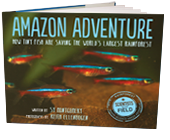Amazon Adventure: How Tiny Fish Are Saving the World’s Largest Rainforest
(Scientists in the Field Series)
HMH Books for Young Readers, ISBN 978-0544352995
“Montgomery thoroughly mines the social and economic effects the piabas have on locals alongside an in-depth exploration of the Amazon river and its ecosystems. The science and sociology are interesting and unusual, and the narrative itself enthralling… A true-to-form installment in a valuable series.”
—Booklist, starred review
“Their trip is reported smoothly and illustrated with well-chosen photographs… An adventure that might help protect an ecosystem.”
—Kirkus
“Color photographs (many underwater) and captivating, take-you-there storytelling immerse readers in the ecosystem . . . An expansive and engaging story of biological interconnectedness and beauty.”
—Publishers Weekly
Whether the youngster on your holiday list is science-minded or a lover of adventure, this entertaining book will offer hours of pleasure. Written in Montgomery’s trademark first-person narration, the text is lively and interesting for readers a lot older than the early teenagers for which it’s marketed. The color photos, some underwater, are amazing.
—The Pioneer Press, St. Paul, Minnesota
“Scientists studying fish ecology in specific biomes often dwell on the evils of overfishing, but along the Río Negro, a major tributary to the mighty Amazon, scientist Scott Dowd has noticed something radically different: a fishing industry that not only supports the human population in this rain forest area but also protects the ecology. Essential to the balance are thousands of tiny fish, or “piaba,” such as cardinal tetras, which are beloved by aquarium keepers for their brilliant shades of neon reds and electric blues. Dowd was appalled on his first visit to the region after seeing the vast numbers of these small fish being brought to the market for sale, believing the entire ecology of the rivers was at risk. He ultimately learned that the majority of them would have died as the rainy season ended and the once-flooded Amazonian forest dried out. Instead, the careful management of the local fishermen preserved the forest and “saved” the fish. Since his initial visit in 1991, Dowd and other members of his research team have been exploring this unusual balance between wild nature and human economy, finding the other animals this industry protects, from pink dolphins to Goliath birdeater tarantulas. Montgomery’s knowledgeable text paints a clear picture of this way of life that’s relatively unknown to many. A plethora of color photos splash across the pages, some muddy in texture owing to the tannin-hued waters of the Río Negro, but their message is as lucid as the text. This fishing industry is a lifesaver. VERDICT Another addition to a spectacular series, this is an eye-opening first purchase for science collections.”
—Patricia Manning, School Library Journal, starred review
“The peripatetic Ms. Montgomery is off again, this time to the Brazilian town of Barcelos on the Rio Negro, one of the two rivers that become the Amazon. The town’s big industry is the harvesting of tropical fish, those dazzling tank inhabitants familiar from pet-store displays, and scientists are partnering with the locals to keep that industry competitive and ecological.
“It might be surprising that biologists are favoring the removal of animals from the wild, but Montgomery makes the advantages clear: the hand-harvesting means the species are at no risk of endangerment, the river’s health stays economically important, new species get discovered, and the locals don’t have to turn to rainforest-destroying agriculture for their incomes.
“The book also explores the life of the piabeiros (the fishers) and their town, chronicling the annual Ornamental Fish Festival where people divide up into teams allied with particular fish and create glorious spectacles with costumes and dance; brief interpolations on the Amazon, its pink dolphins, the local tarantulas, and other aspects of the region add breadth. This effectively hits the marks of some previous Scientists in the Field titles by tying the ecology of a region to the economy of its inhabitants, and it makes that often complicated connection accessible and logical in its Amazonian context.”
—The Bulletin for the Center of Children’s Books

